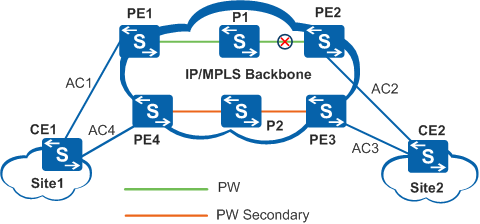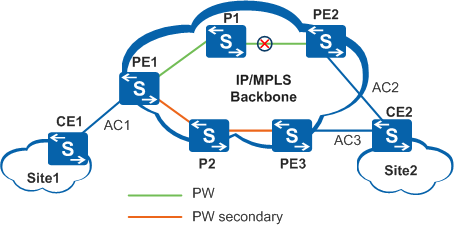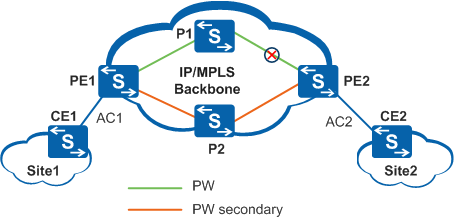PWE3 FRR
Definition
As L2VPN is widely used, networks especially L2VPNs that carry real-time services such as VoIP and IPTV require high reliability.
Pseudo-Wire Emulation Edge to Edge Fast Reroute (PWE3 FRR) is a feasible solution to improve L2VPN reliability. It uses Operations, Administration and Maintenance (OAM) and Bidirectional Forwarding Detection (BFD) to detect and report faults on the L2VPN and fast switch traffic, then improving L2VPN reliability.
PWE3 FRR Implementation
PWE3 FRR is implemented as follows:
The BFD mechanism is used to fast detect a fault on a PW. As a unified detection mechanism used on the entire network, BFD can detect a fault in milliseconds. As the BFD cost is low, if a great number of PWs exist, BFD for PWs greatly reduces the system cost.
The OAM mapping between a PW and an AC can be created. When a PW or a PE is faulty, a CE can take measures in a timely manner. For example, the CE can rapidly switch traffic to the secondary path.
OAM messages are transparently transmitted on a PW so that this mechanism implements end-to-end fault detection on PWs and provides PW protection.
In this way, OAM integrates with BFD to implement PWE3 FRR.
Switchover Mechanism
A fault on the PWE3 FRR network triggers traffic switchover. The device where traffic is switched also reports the fault and terminates fault notification.
The node that performs fault switchover and terminates fault notification varies with the networking:
In a CE dual-homing networking as shown in Figure 1, the CE terminates fault propagation. When an AC or a PW is faulty, the fault is notified to the CE, and the CE performs the fault switchover.
In a networking with asymmetrically connected CEs as shown in Figure 2, PE1 and CE2 terminate fault propagation. When PE1 detects a fault, it switches traffic and does not send a fault notification to CE1. CE2 receives the fault notification from PE2 and switches traffic to the secondary link.
As shown in Figure 3, two tunnels back up each other on a backbone network. PE1 and PE2 terminate fault notification, and only need to switch the tunnel.
When a CE detects a fault on the primary link, the CE checks whether the secondary link is available. If so, the CE switches traffic to the secondary link. If not, the CE sends an alarm about the service fault.
In a networking with asymmetrically connected CEs as shown in Figure 2, when PE1 detects a fault on the primary PW, it processes the fault as follows:
If PE1 also detects a local AC fault, it reports a service fault. In this case, the fault cannot be rectified.
If PE1 does not detect a local AC fault or a secondary PW fault, it switches traffic to the secondary PW.
If PE1 does not detect a local AC fault but detects a secondary PW fault, it reports a service fault, but does not switch traffic.
PW Revertive Switchover Policy
In a networking with asymmetrically connected CEs as shown in Figure 2, when PE1 is notified of fault recovery on the primary PW, PE1 works based on the configured revertive switchover policy.
The PW revertive switchover policies are as follows:
None revertive switchover: Traffic is not switched to the primary PW.
Immediate revertive switchover: Traffic is immediately switched to the primary PW.
Delayed revertive switchover: Traffic is switched to the primary PW after a delay.
After the switchover, PE1 immediately notifies PE3 on the secondary PW of the fault so that CE2 fast switches the AC through association. In addition, the PE notifies the peer PE on the secondary PW of fault recovery immediately or after a delay, preventing packet loss due to transmission delay between PEs.


